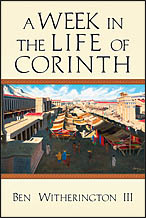Ben Witherington: A Week in the Life of Corinth
 Ben Witherington III, A Week in the Life of Corinth (Downers Grove, IL: InterVarsity Press, 2012), 158 pages, 9780830839629
Ben Witherington III, A Week in the Life of Corinth (Downers Grove, IL: InterVarsity Press, 2012), 158 pages, 9780830839629
Thirty years ago, I read James Michener’s novel, The Covenant. Like so many of his historical novels, it is marked by well-researched and detailed historical background. Many twists and turns of the inter-generational plot line have faded since then, but its telling of four and a half centuries of South African history remains clear. Likewise, giving background is what Witherington aims at with his readers.
Yet, the title deceived me. This is not a week’s worth of readings on Corinthian archeological findings and their cultural meaning. In fact, it does not take much to extrapolate some of Witherington’s material into a wider Greco-Roman understanding. It is not a reference book. Nor can one move through it consecutively and exactly follow along in 1 Corinthians. It is a short story, lasting one week, set in first century Corinth that can stand on its own. What makes this book unique and valuable is that Witherington has taken great pains to get the details of the historical setting correct and to explain them to us. On almost every page our list of background facts is increased either by a quick explanatory phrase or shaded pages titled, “A Closer Look.” We are introduced to things as wide-ranging as the Apostle Paul’s physical appearance to Greco-Roman home schooling. The beauty of it all is that this and much more jumps from the pages into our minds painlessly and without tedium because it is all under the cover of a short story.
The story itself uses characters found in NT epistles who are then wrapped into fictional relationships and backgrounds. The plot is plausible and at times moving as it combines tension, friendship, some divine intervention, and even a hint of romance. This book can entertain while it secretly educates, making it suitable for teen as well as adult general reading.
Several “Closer Looks” show the value of the book. “Patrons, Clients and Reciprocity Conventions” maps out the differences between contemporary and Greco-Roman social relations. Clearly, this discussion hopes to deliver us from reading into such terms as “friendship” our own understanding and experience. Before banking, there was patronage. Wealth and privilege were confined to the upper five per cent of the highly stratified Corinthian population. From the upper crust came financial patronage to suitable clients who are not to be confused in any way with modern borrowers. Clients became more like hired hands at the beck and call of the patron. This helps explain Paul’s boast of meeting his own needs by his tent making trade, not by receiving any support from Corinthian sources. He was controlled by no one and showed his pure motivation by his independence. From such a note can be gained an appreciation of the social minefield Paul the cross-cultural missionary had to navigate. For NT understanding, it is important to note that the relationship between patron and client was quite often called a friendship; yet, how different from our current understanding. It gives us pause, as the cultural setting of the NT moves from Jewish to Greco-Roman, to be aware of the different use of the word “friend.” Additionally, translating the Greek “adelphos,” literally, “brother,” is not done well in a few contemporary versions by using the word, “friend.”
Category: Biblical Studies, Winter 2014


